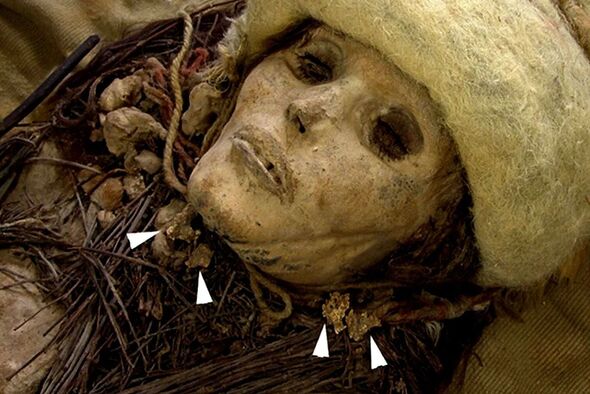An unusual substance found on the necklace of a 3,500-year-old mummy has rewritten part of human history.
Archaeologists say the bizarre jewellery is adorned with what is thought to be the world’s oldest cheese. It was found on a body entombed in an ancient burial site in Xinjiang in northwestern China.
Throughout history, humans have been buried with treasures and times of great cultural significance. And archaeologists say the Chinese “cheese necklaces” are a thrilling piece of ancient history that offers an insight into the region’s dairy-producing past during the Bronze Age.
The lactose-rich lumps are the oldest examples of cheese ever discovered. And a new study says it reveals long-hidden information about human culture.
The delicacy also shows a potential path for how dairying practices may have spread across Asia, says research published by the journal Cell yesterday, September 25. And, as well as originating in what is now Russia, it appears cheese may also have been developed in the area we now call China.
The study’s co-author Qiaomei Fu, a paleontologist and paleoanthropologist at the Chinese Academy of Sciences, said the new analysis points to two different geographic origins of kefir-making – one in Xinjiang and one in the Caucasus.
Fu told Popular Science that research “strongly suggests the distinct spreading routes of two [kefir microbe] subspecies”. This was likely the result of wide-ranging nomadic groups traveling across the dry grassland of Eurasia, added Fu.
Shevan Wilkins, group leader of ancient proteins at the University of Basel in Switzerland, suggests it is the oldest cheese in existence. The biomolecular archaeologist said: “I can’t think of another place where you have preserved cheese from that long ago.”
The cheese necklace was first found about two decades ago. However, this new study uses DNA to shed more light on the origins of this dairy delight.
Genetic analysis revealed that they are a kefir cheese. This is a fermented and dried dairy product featuring bacteria, yeast, and fungi – and is similar to modern day kefir, which is usually drunk as a sour liquid similar to a thin yogurt.
Kefir granules ferment milk in a similar way to rennet, which is commonly used in European cheesemaking. Commenting on the study, Christina Warriner – a biomolecular archaeologist at Harvard University – told Popsci.com it’s thought “dairying” is a technology that predates the invention of pottery, in the neolithic (stone age) period – dates back at least 9,000 years.
Both scientists offered opinions about what this ancient cheese might have tasted like. Warriner said that as traditional Asian dairy products contain a lot of lactic acid because of how they’re fermented, the cheese would likely have been “quite sour”.
Wilkins concurred about the cheese’s probable sourness. She also suggested it would be “funky” and “distinctive”.
“If I could go back in time, I’d probably just try to eat and taste a lot of food,” said Wilkins.
